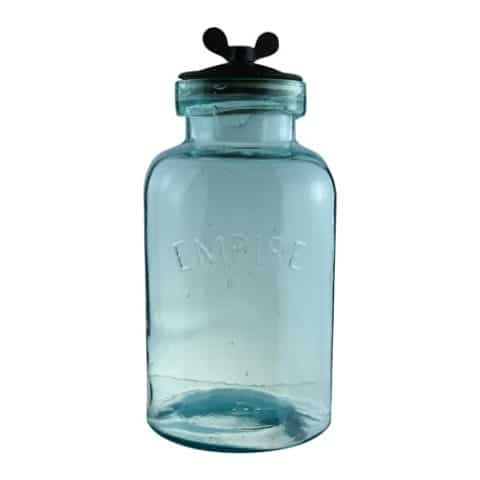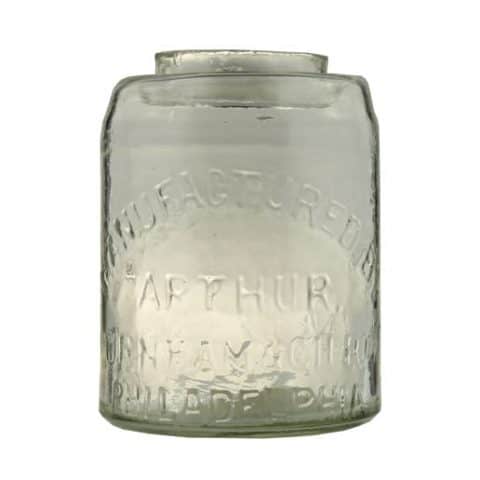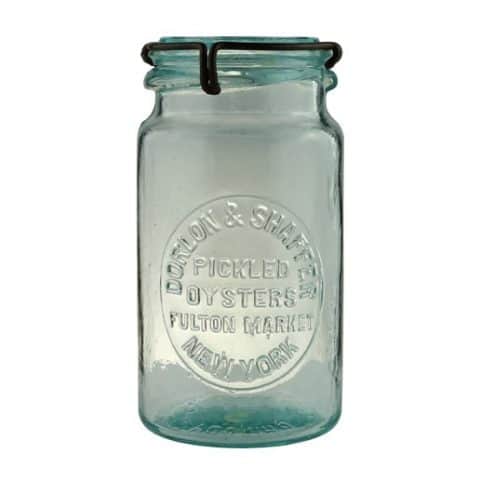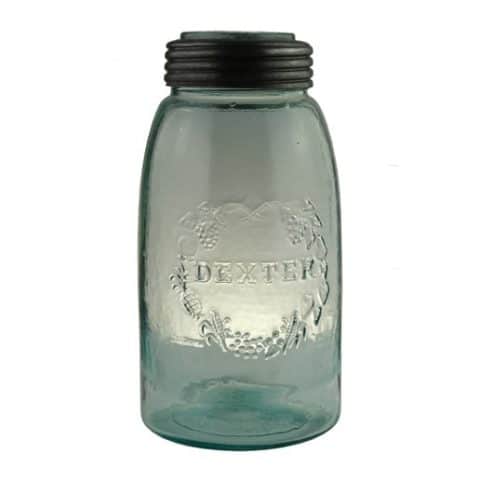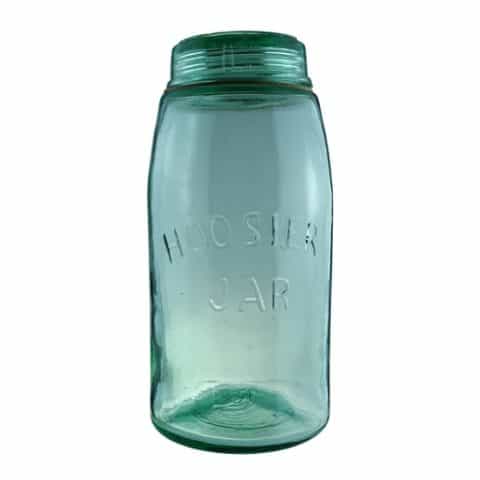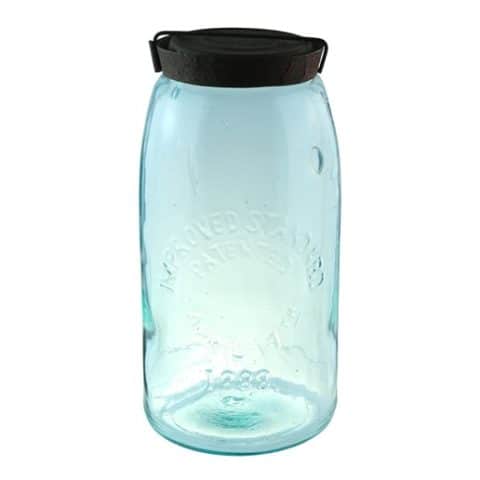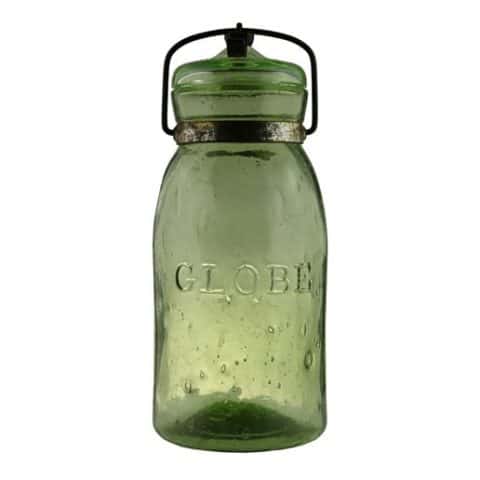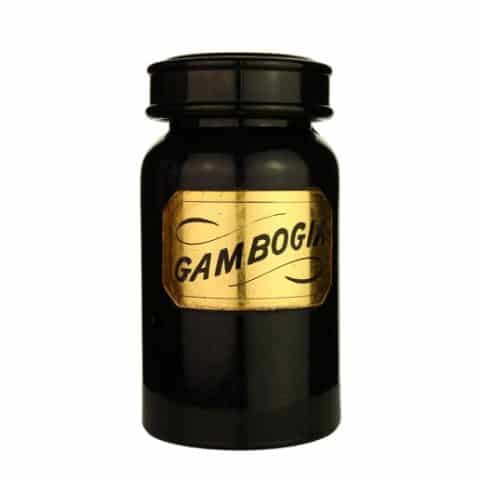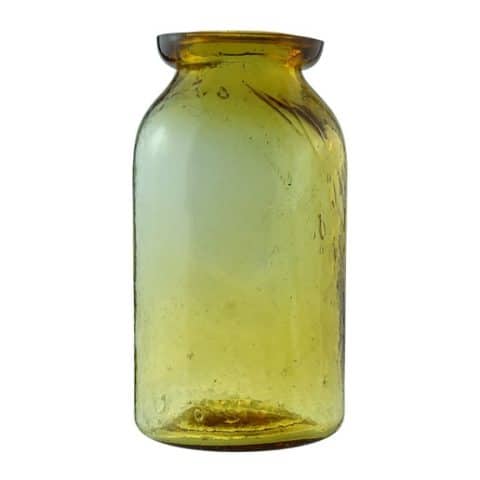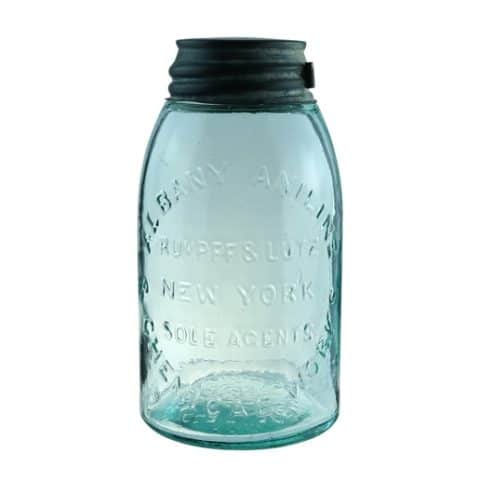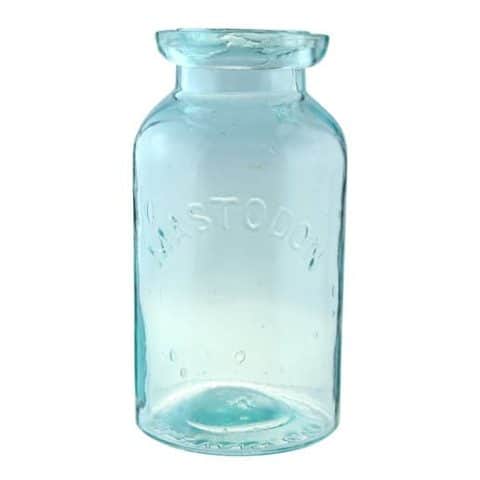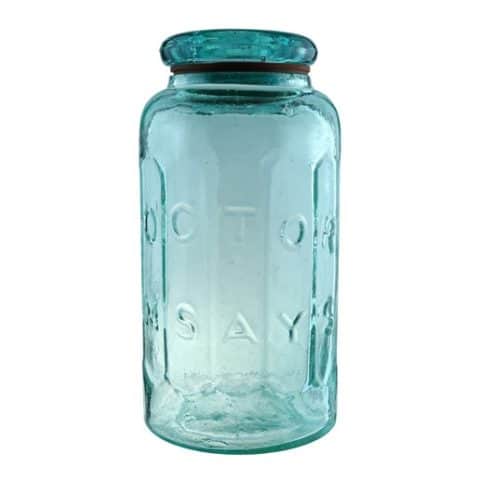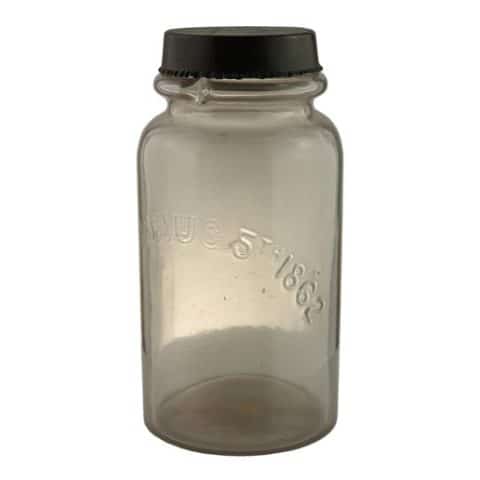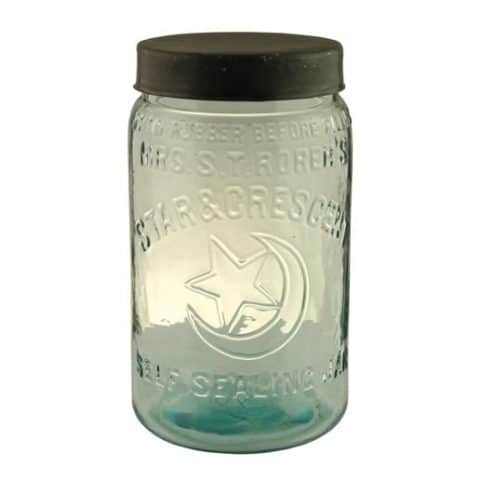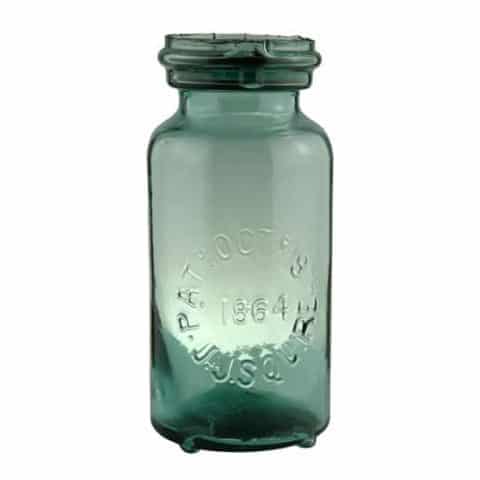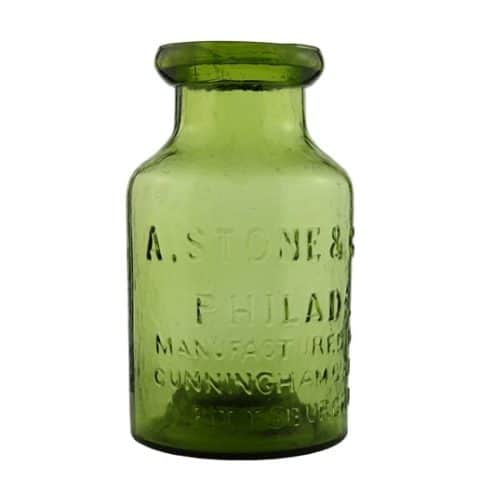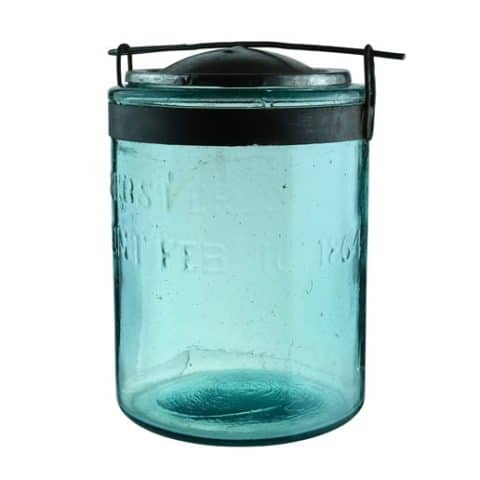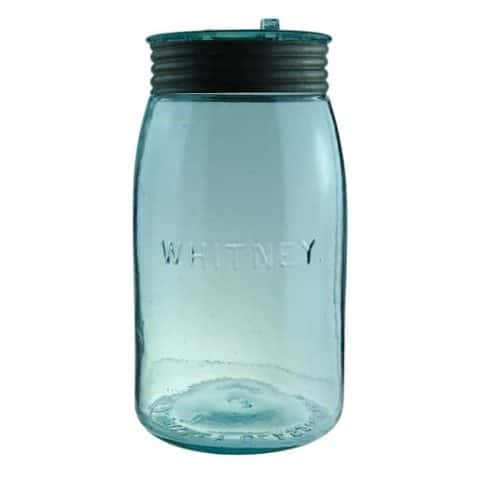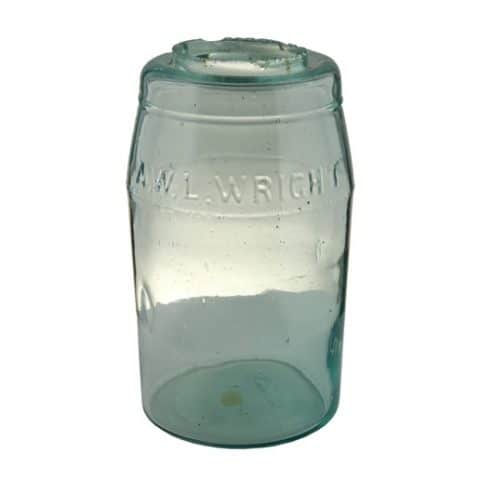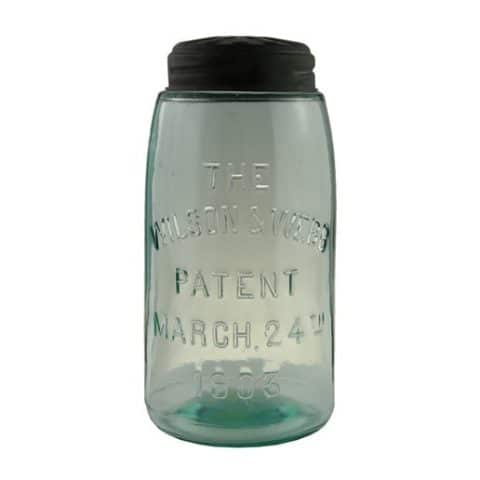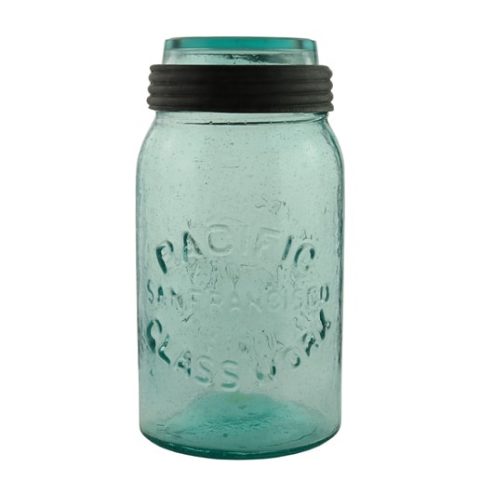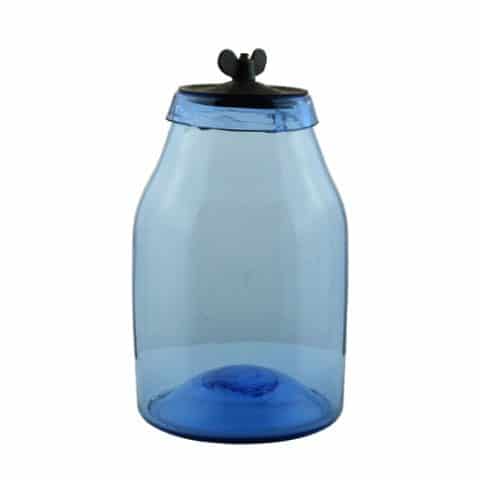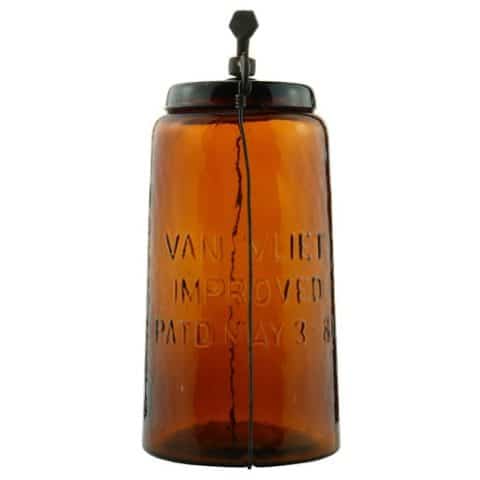Flaccus Bros. Steers Head Fruit Jar
Flaccus Bros.
Steers Head
(Embossed Steer’s Head)
Fruit Jar
Flaccus Brothers, George A. Flaccus, William C. Flaccus, Edward C. Flaccus and Charles C. Flaccus
Wheeling, West Virginia and New Philadelphia, Ohio
Emerald Green Pint
Provenance: Darrell Plank Collection

Flaccus Bros. Steers Head Fruit Jars have tremendous eye appeal with their ornate decorative markings and typography surrounding a pictorial embossed steer’s head. These product jars can be found with matching glass caps and are typically found in pints.
The Flaccus Brothers were wholesale and retail “Fancy Grocers” located in Wheeling, West Virginia. Their famous Steer’s Head Catsup was the house specialty.

The subject pint cylindrical jars are surrounded on the top and bottom with an embossed motif of flowers, leaves, fruit, and nuts. A grapevine motif centered around a five-pointed grape leaf with bunches of grapes to the sides occurs on the top band although the exact shape and surroundings vary. The lower design centers around a multi-petaled, three-layered flower, probably a chrysanthemum, and this motif also can vary.
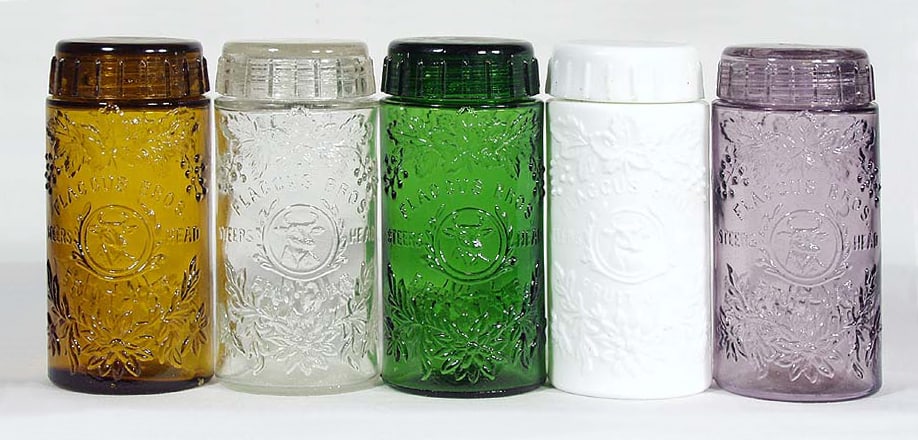
The jar face is embossed ‘FLACCUS BROS. STEERS HEAD’ (Embossed Steer’s Head) ‘FRUIT JAR.’ The “Flaccus Bros.” copy is arched over an embossed Steer’s Head that is facing partially right. The head is surrounded by an embossed circle and horseshoe-shaped laurel. Flanking this pictorial motif is bisected embossed horizontal copy reading, “Steers” and “Head.” Beneath the motif is embossed copy in a concave arch reading “Fruit Jar.” The reverse of the jar, between the motif, was left without decoration and is where a “bow-tie” paper label would have been placed.
The jars are hand-blown with a ground lip. The closure is a top seal straddle lip with a glass screw cap. The cap is embossed, ‘TO REMOVE CAP PRESS DOWN & UNSCREW.’ There are a number of closure variations.
The jars can be found in yellow and honey amber, clear or colorless that could be turned to a sun-colored amethyst, white milk glass, and emerald green glass, like our museum example, which is considered very rare.

That these jars were originally packed with mustard. The labeling space on the reverse is exactly the right size for the bow-tie label, and existing jars have the mustard label in place. However, the term “FRUIT JAR” was prominently embossed below the steer’s head. This strongly suggests that the Flaccus Bros. had a long-term sales campaign where the mustard jar could be reused as a fruit jar.

The jars produced by the E. C. Flaccus Company, also of Wheeling, West Virginia, should not be confused with their similar-looking jars typically embossed ‘E. C. FLACCUS CO.’ (Embossed Stags’s Head) ‘TRADE MARK.’ Edward C. Flaccus was one of the Flaccus brothers.

Flaccus Brothers
The involvement of the Flaccus family with glass containers is complex and involved. Our jar is a product of the Flaccus Brothers who were in business from 1878 to 1905 or so in Wheeling, West Virginia.

George A. Flaccus was the originator and proprietor of the firm of Flaccus Brothers, which at one time had the largest fruit preserving plant in West Virginia, and another large preserving plant at New Philadelphia, Ohio. George was a resident and prominent citizen of Wheeling, West Virginia, and was born in Washington County, Ohio. He was the son of George C. Flaccus who lived a retired life for many years at his home near Altenheim, two and a half miles east of Wheeling, on the National Road.
The father, George C. Flaccus was a native from the Rhine district of Germany and came to the United States in 1848 with his brother William, first settling in Pittsburgh, Pennsylvania. While in Pittsburgh, George C. Flaccus married Amelia Blanchett, and they later moved to a farm about eight miles from Marietta, Ohio where their first son, George Andreas Flaccus, was born on June 2, 1858. The family came to Wheeling, West Virginia in 1865 at the close of the Civil War where George C. Flaccus established and operated a glue manufactory. In 1877, he left this business to establish Geo. C. Flaccus & Son who were grocers. Both their business and living address was 2271 Market Street. The son was George A. Flaccus.
George Andreas Flaccus was reared and educated in Wheeling, where he attended the public schools, Linsly Institute, and the Wheeling Business College. In 1878, he, together with his brothers, William, Edward, and Charles founded Flaccus Bros., a wholesale and retail grocery store, manufacturing much of the goods that they sold.

The first Flaccus Brothers plant was located at Altenheim, where the business was begun in a small way, together with the grocery at the corner of Market and 23rd Streets. In 1890, the business was moved to the corner of 17th and Chapline Streets. Mincemeat and canned goods were first manufactured, but in later years the famous Steers-Head Catsup became the house specialty being manufactured and shipped by carloads, together with preserves, pickles, sauces, chow-chow, mustard, fruits, and nuts. etc., to all parts of the country.
The Flaccus buildings occupied the entire square on 17th Street, from Chapline Street to Eoff Street, and were well equipped with up-to-date machinery, specially adapted for the purpose designed, most of it invented by the firm. About 60,000 square feet of floor space represented the Wheeling plant, while the New Philadelphia plant had about 30,000 square feet.

The Flaccus Brothers were the first firm of its kind to engage in the manufacture of their line of goods in Wheeling and among the first west of the Allegheny Mountains, as then most manufacturers of these goods were located in Eastern Pennsylvania, New York, Maryland, and New Jersey. The Flaccus Brothers had contracts with the farmers and gardeners in the territory adjoining Wheeling and at their plant in New Philadelphia, Ohio, to furnish most of the necessary products, while large supplies were also drawn from other large fruit centers.
The firm had agents and salesmen in all parts of the country, from Maine to California, particularly in the largest cities to partly supply the ever-increasing demand for their products.
George A. Flaccus probably adopted the elaborate steers head jars about the time Edward C. Flaccus left the Flaccus Brothers in 1897 as the jars were advertised in 1898. Edward Flaccus adopted his similar jars with a stag head it was most likely in 1898 or 1899. Jars from both firms were made in the same colors. The shades for each firm were virtually identical, indicating that the same glass house made jars for both packing firms.
Support Primary Image: Flaccus Bros Steers Head Fruit Jar in emerald green imaged by the FOHBC Virtual Museum midwest studio by Alan DeMaison.
Support Images: Secondary jar images courtesy of Greg Spurgeon and North American Glass
Support Image: Auction Lot 483: Yellow Amber Pint FLACCUS BROS STEERS HEAD FRUIT JAR, A deep yellow-amber pint FLACCUS BROS STEERS HEAD FRUIT JAR. Shiny glass in fine shape with no damage or stains. Thick ground rim with the usual edge roughness. Comes with the correct original matching deep yellow amber-colored glass lid. The threads inside the lid have the typical roughness and flaking, but the lid twists onto the jar smoothly. Base: unmarked. – Greg Spurgeon, North American Glass
Support Image: Auction Lot 13402: FLACCUS BROS STEERS HEAD FRUIT JAR, Size: Pint, Color: Deep Brilliant Yellow Green, Closure: rare correct original glass screw cap (normal flaking on the internal thread), Appearance: sparkling glass, Condition: jar in great shape, normal flaking of the ground mouth, Embossing: strong, Base: unmarked, Age: late 1800s, Availability: A beautiful example of this highly appealing Flaccus jar in a vivid color. Rarely is the original lid found on the green jars. For whatever reasons, the green lids were almost always damaged or lost. This one is a rare survivor. – Greg Spurgeon, North American Glass
Support Image: Auction Lot 8177: FLACCUS BROS STEERS HEAD FRUIT JAR pint, colorless, Closure: Original one-piece glass screw cap embossed on the bottom side “TO REMOVE CAP PRESS DOWN & UNSCREW”. The cap has the usual flaking along the threads, and a small flake on the bottom edge. Appearance: shiny glass with a trace spot of haze. Condition: normal roughness of the ground mouth, Embossing: strong. Base: unmarked. Age: late 1800s, Availability: scarce early version with ground mouth – Greg Spurgeon, North American Glass
Support Image: Auction Lot 6331: FLACCUS BROS STEERS HEAD FRUIT JAR, Size: Pint, Color: White Milk Glass. Closure: original one-piece glass screw cap embossed on the bottom surface “TO REMOVE CAP PRESS DOWN & UNSCREW” (thread flakes as is typical). Appearance: good. Condition: normal nicking of the ground mouth. Embossing: strong. Base: unmarked. Age: late 1800s, Availability: scarce and a sharp-looking example – Greg Spurgeon, North American Glass
Support Image: Secondary jar grouping from Jerry Ikeda and Jerry’s Jars web site
Support Image: Secondary jar image from Jeff Wichmann and American Bottle Auctions
Support: Reference to History of Wheeling City and Ohio County, West Virginia and Representative Citizens, by Hon. Gibson Lamb Cranmer, 1902.
Support: Reference to Flaccus: Grocers to a Nation by Deanna and Tom Caniff
Support: Reference to The Dating Game: The C.L. Flaccus Glass Co. by Bill Lockhart, Pete Schulz, Carol Serr and Bill Lindsay, Bottles and Extras, November-December 2007
Support: Reference to The Flaccus Bros., E.C. Flaccus and Their Fabulous, Colorful, Embossed Jars by Bill Lockhart, Barry Bernas, Pete Schulz, Beau Schreiver, Carol Serr, and Bill Lindsey
Support: Reference to Red Book #11, the Collector’s Guide to Old Fruit Jars by Douglas M. Leybourne, Jr.
Support: Reference to Fruit Jar Annual 2020 – The Guide to Collecting Fruit Jars by Jerome J. McCann
Join the FOHBC: The Virtual Museum is a project of the Federation of Historical Bottle Collectors (FOHBC). To become a member.





















